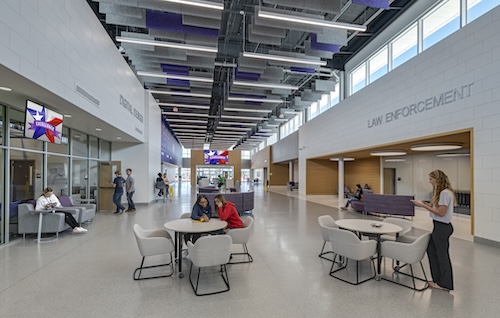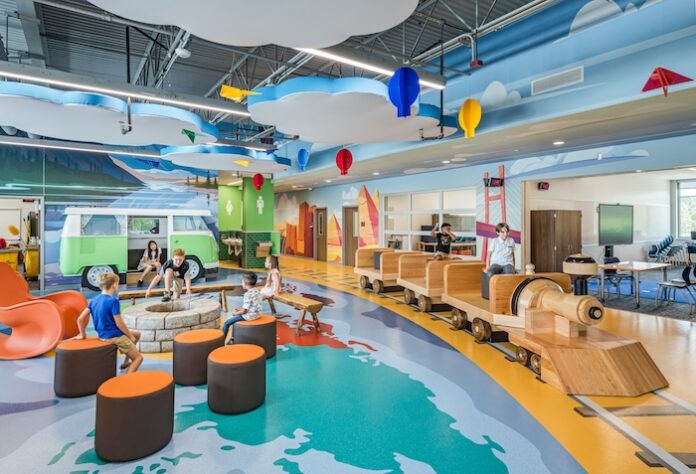Two concepts are driving school designers these days: physical safety and emotional well-being. The climate created by new designs can help superintendents and their teams strengthen school climate and tackle some of their biggest challenges, including chronic absenteeism.
To help K12 leaders envision new learning environments, District Administration chatted with Melissa Turnbaugh, a partner and national education and innovation leader at the architectural firm PBK, which specializes in school design.
1. What aspects of school design should be prioritized to make students comfortable?
Turnbaugh: “Creating a conducive and comfortable atmosphere for students at school requires a dual focus on physical and emotional well-being. Physical safety measures, such as established security protocols, limited access, security film, cameras and unobstructed visibility, are essential to provide a secure environment. Equally important is fostering emotional safety, achieved through learning spaces that cater to diverse needs—offering various sizes and scales to accommodate different learning styles.
“These environments should be warm and inviting, characterized by abundant natural light, clean air, and adaptable furniture, promoting a sense of ease and security. Additionally, ensuring access to outdoor spaces is crucial, as studies show that spending time outside contributes positively to students’ physical and emotional well-being, enhancing attention spans and test scores and addressing behavioral issues.
“Given the substantial time students invest in the school environment, it is imperative that the surroundings actively contribute to their overall support and comfort, addressing both their physical and emotional needs.”
2. How do lighting, furniture and other design components help increase attendance?
“Boosting attendance is directly linked to creating an appealing and immersive school environment. Even simple adjustments, such as introducing natural light into classrooms, have demonstrated a positive impact on both student and teacher attendance as well as academic performance. A recent article in The New York Times highlighted a concerning nationwide increase in school absenteeism, emphasizing that ‘research consistently indicates that student attendance is a powerful predictor of virtually every other outcome.’
“The solution to this issue is multifaceted. According to the EPA, maintaining indoor air quality is another crucial factor that can contribute to increased daily attendance and decreased dropout rates. Furthermore, fostering a positive perception of school and promoting engagement can be pivotal. A study involving first graders who had the opportunity to manipulate and control their furniture revealed higher levels of engagement and attendance.”
Read more from DA: Latest school closures force leaders everywhere to make tough choices
When these solutions are integrated, addressing factors such as lighting, air quality, and student engagement, they collectively serve to improve both student and teacher attendance rates, ultimately contributing to enhanced retention within the educational system.
3. Describe some innovative designs schools have adopted for classrooms and other spaces, and how they are conducive to learning.
“Educational institutions are adopting innovative approaches to space utilization, promoting flexibility and extension for both students and teachers. One strategic design involves integrating collaboration spaces directly adjacent to classrooms, allowing educators to securely send students outside the traditional setting for activities like small group instruction, personalized learning, coaching or simply a peaceful break.
“Moreover, various areas across the campus are repurposed for learning purposes, utilizing outdoor spaces for classroom activities and providing designated areas for students requiring moments of de-escalation and reset.

“This comprehensive use of every inch of the school campus for learning and instruction not only facilitates a diverse range of choices and spaces but also aligns with the principle of responsible resource stewardship. Such intentional design encourages adaptability, promotes a variety of learning environments and maximizes the educational potential of the entire school infrastructure.”
4. What new types of furniture are schools installing to increase student comfort and achievement?
“Recognizing the significance of accommodating diverse learning needs, schools are increasingly valuing the use of flexible and adaptable furniture. Both students and teachers appreciate the versatility provided by furniture that can be easily rearranged to suit specific programs or projects.
“Furthermore, in catering to students with distinct learning requirements, adaptable furniture allows for rocking or wiggling, contributing to the maintenance of attention spans and focus. The furniture in educational settings must align with the specific type of learning taking place, thereby enhancing the overall effectiveness of the learning environment.”
5. How does design improve teacher retention, confidence and well-being?
“A concerning trend is the high rate at which teachers are leaving the profession. As previously noted, teachers must experience a sense of support within the school environment. This encompasses not only physical safety, ensured through the implementation of safety measures and improved air quality post-pandemic, but also support in the realm of teaching. This involves providing tools such as voice amplification and creating teaching environments that align with their individual styles, including the incorporation of flexible furniture.
“Additionally, teachers require intentional spaces where they can collaborate with peers, fostering their well-being, promoting connections and facilitating ongoing professional development. Recognizing and addressing these multifaceted needs is essential to retaining educators within the teaching profession.”
District Administration’s Superintendent’s Playbook series examines how superintendents, principals and other administrators are solving common problems that today’s educators are facing.










